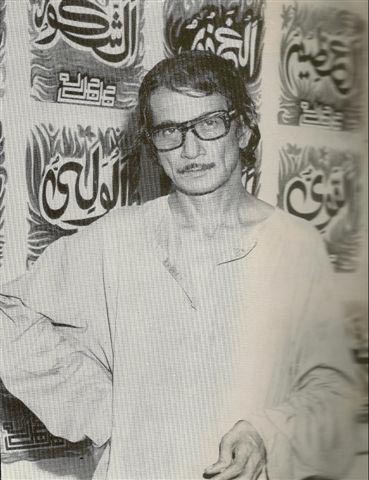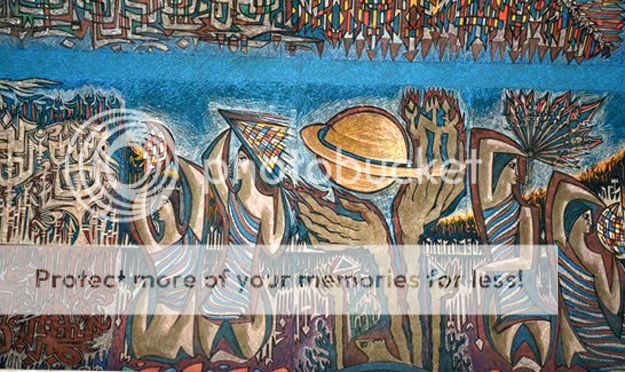ghazi52
PDF THINK TANK: ANALYST

- Joined
- Mar 21, 2007
- Messages
- 101,751
- Reaction score
- 106
- Country
- Location
...................................
Sadequain - Remarkable Messenger of Pakistani Art
Sadequain traveled all over the world long before it became fashionable and accessible to his generation. His paintings were widely displayed on all continents and received praise from public and connoisseurs alike and commanded generous press coverage..............
.
..........

..






..
Sadequain - Remarkable Messenger of Pakistani Art
Sadequain traveled all over the world long before it became fashionable and accessible to his generation. His paintings were widely displayed on all continents and received praise from public and connoisseurs alike and commanded generous press coverage..............
.
..........

..
- 1930, Born in Amroha, UP, India.
- 1948, Graduated from Agra University in Art History. Migrated to Pakistan.
- 1954-60, Held numerous one-man exhibitions at Quetta Residency, and in Karachi at Prime Minister H. S. Suhrawardy’s residence, Frare Hall, executed murals in Jinnah Central Hospital, Karachi Airport, Services Club, and Mangla Dam Committee Room.
- 1960, Awarded "Tamgha-e-Imtiaz" and First Prize in the All Pakistan National Exhibition of Paintings. Visited France at the invitation of the French Committee of International Association of Plastic Arts and awarded Laureate Biennale de Paris by the International Jury of Critics.
- 1961, Executed several murals, including “Treasures of Times” in the Headquarters of the State Bank of Pakistan, Karachi.
- 1962, Awarded president’s medal for "Pride of Performance." Exhibition at "Musee Maision du Culture". Le Havre, France. One-man Exhibition at Galerie Lambert, Paris and permanent exhibition at Galerie Mona Lisa, Paris.
- 1963, Visited USA, UK, and France. Exhibition at Henry Gallery, Washington. Exhibition at the Commonwealth Institute Galleries, London. Exhibition at the N.V.C. Gallery, London. Exhibition in the 5th Salon of the "Young and Great Artists" at the Museum of Modern Art, Paris.
- 1964, Exhibition at Galerie Presboug, Paris. Selected to do color
- lithographs for a special publication of the novel by Albert Camus, L’ Etranger, published by the Automobile Club of France.
- 1965, Several exhibitions in France including at Nouran Havre, Palais de la Mediterrinean, Chateau-Musee Annecy, Musee Casino Dieppe, Casino de Charbonnieres, and Musee Macon. Also exhibition of Paintings at the Arts Council Gallery, Karachi and at Alhamra, Lahore.Executed the mural "War and Peace" at Karachi.
- 1966, Retrospective Exhibition of 300 paintings at the Banking Hall of the State Bank Headquarters, Karachi. Exhibition on Lloyd Triestino's ship "Victoria" while crossing the Red Sea, the Mediterranean Sea and the Adriatic Sea.Executed a mural in Lusanne, Switzerland entitled "Pakistan" in the Pakistan Pavilion in the Swiss Fair. Later on that mural was exhibited in New York and Tokyo and now it is permanently installed in Toronto, Canada. Executed a mural "Flight" in the PIA, Office at Paris.
- 1967, Executed the mural entitled"Saga of Labor" at Mangla Dam Power House. Executed a Mural "The Light of the Book" in the Punjab Public Library.
- 1968, Executed the mural "Quest for knowledge" for the library of the University of Punjab. Executed murals for the Auditorium of the Punjab University entitled “The Confrontation” and “The Triumph.” Exhibition of Murals and Paintings at "Al Hamra.” Held series of exposition of paintings at the PIA Auditorium titled "Barbed Wire," "Reflection Series," and Exposition of 25 paintings, illustration on the verses of Mirza Ghalib. Also exposition of the Calligraphies of Verses of the Holy Quran executed during the month of Ramzan.
- 1969, More paintings based on the poetry of Ghalib to celebrate the death centenary of Ghalib. Exposition of paintings based on the poetry of Ghalib and Calligraphies of the concerned verses at the Arts Council Buildings, Karachi. Composed some 1500 Rubbaiyyat. Painted about 100 paintings on the themes of Rubaiyyat. First Edition of the "Rubaiyyat-e-Sedequain-e-Naqash" appeared.
- Exposition of Paintings and Poetry with Calligraphy at the Arts Council Building, Karachi. Started Calligraphy of "Sura-e-Rahman:" Concentrated on calligraphy resulting in an Exposition of Calligraphic works during the month of Ramzan 1390 A.H. at the Arts Council of Pakistan, Karachi. After floods in East Pakistan painted a large mural on the theme of man's struggle against the hostile forces of nature. That mural was donated to the Naval Head-quarters, Queen's Road, Karachi, and it was housed there. Later shifted to Istanbul Turkey.
- 1970, Exposition of the Calligraphic works at the Library of Headquarters of the State Bank of Pakistan during the International Islamic Conference. Executed some large drawings, paintings and calligraphies based on the poetry of Faiz Ahmed Faiz to celebrate the 60th Birthday of Faiz Ahmad Faiz.
- Made some 200 pen and ink drawings for the illustrated edition of Rubaiyyat-e-Sadequain-e-Naqash" and wrote the preface of the "Bayaz-e-Sadequaini".
- Exposition of the paintings based on Ghalib's poetry side by side. Executed "Sura-e-Yasin" 260 ft. on wooden panels for the Islamic Gallery and donated it to the Lahore Museum. Exhibition of Calligraphic works at the Arts Council of Pakistan Karachi, while being admitted in the Jinnah Hospital.
- Executed the ceiling at the Lahore Museum's central gallery. Finished the ceiling on 3rd August 1973, and gave it away as a gift to the wheat colored beauties of Lahore.
- Exposition of the Calligraphic works at the Liaquat Memorial Hall, Rawalpindi.
- 1974, Worked on Calligraphic Paintings. Preparations of the "Air Mail Edition" made for the Middle East Traveling Exhibitions.
- Municipal Library Hall, Dubai (U.A.E.)
- Main Hall, Hilton Hotel, Abu Dhabi (U.A.E.)
- Markazul Funoon, Jeddah (Saudi Arabia)
- Ardul Muarad, Museum of Cairo, (Egypt)
- National Museum of Damascus, Damascus, (Syria)
- Hall of Jardon Intercontinental, Amman (Jordon)
- National Art Gallery of Kuwait, (Kuwait).
- Museum of Modern art, Baghdad (Iraq)
- 1975, Wrote quatrains and made line drawings only. Painted two large murals for the Sports Complex, Islamabad. Converted Montgomery Hall into his painting workshops. The theme was the struggle for emancipation,fighting for freedom of the nations of Asia and Africa Their fight against imperialism.
- 1976, Calligraphed 99 "Isma-e-Husna" on squarish pieces of Chip Board. Now permanently in the Islamic gallery Lahore museum as a gift to the city.
- 1977, Did some two hundred line drawings and composed Rubaiyat (quatrains). Paintings based on lqbal's poetry. A series of films "Mojiza-e-Fun" was made by the Lahore T.V. Exhibition of Calligraphy in Punjab Arts Council. Exhibition of paintings based on the poetry of lqbal in the Lahore Museum.
- 1978, Books of poetry along with illustrations. The whole year was devoted to calligraphy. An exhibition of Arches followed during the month of Ramazan of 1399 AH in Lahore museum. Now they are permanently fixed in the Islamic Gallery of Lahore museum as a donation by the artist.
- 1979, More Calligraphies. National bank of Pakistan calligraphic mural some smaller murals for the said Bank and during the same period, made nine more calligraphic murals for the Lahore museum as a permanent feature of the Islamic gallery as a gift. Some fine compiled books of quatrain with illustrations. Published personal letters to the Elder brother Kaz-e-man exactly as they were written from Europe and America during the sixties.
- Spectacular permanent manifestation of the works of Calligraphy in the Lahore museum's Islamic Gallery. More murals were added into the Architectural setting of the Gallery. Went to Abu Dhabi, on a special invitation of the ministry of Water and Electricity to do a calligraphic mural in the lobby of the prestigious power station at Urn-ul-Naar. Awarded "Sitara-e-lmtiaz".
- In Bahrain, International Islamic Exhibition on the turn of the century of Hijra: Pakistan was represented with only Sadequain's Calligraphies. The Pakistan section was visited by His Highness the Amir of Bahrain together with Mr. Yasir Arafat. The Pakistan section was awarded the first prize. Left the Trophy to be kept in the Pakistan Embassy, Bahrain. Invitations from Istanbul and London for exhibitions.
- 1980, Hijra Celebrations in Karachi by holding first an Exposition of Calligraphy.
- 1981, Inauguration of Galerie Sadequain in Islamabad. Arrived at New Delhi after 33 years. Visited Amroha. Exposition of Calligraphies, International Trade Fair, New Delhi. Exposition of Paintings and Drawings sponsored by Indian Council for Cultural Relations at State Lalit Kala Academy, Rabindra Bhawan, New Delhi.
- 1982, Exhibition of Calligraphies and Drawings at Kennedy Hall, Aligarh Muslim University, Aligarh.
- Executed the Calligraphy of the University motto for Moulana Azad Library, A.M.U. Aligarh.
- Executed a Metallic Mural for the exterior of the Department of Geography, A.M.U. Aligarh.
- Exhibition of Paintings & Calligraphies, Jamia Millia Islamia, New Delhi.
- Exhibition of calligraphies & Drawings at Urdu Ghar, Hyderabad, Deccan, along with a small mural for the Urdu Ghar.
- Mural of Earth Sciences in National Geophysical Research Institute, Hyderabad, Deccan, Unveiling Ceremony.
- Visited Varanasi. Executed a mural Quest for Reality for Banaras Hindu University.
- Unveiling of the mural by Raja Sahab of Banaras at Bharat Kala Bhawan. B.H.U. Varanasi, India.
- Exhibition of Calligraphies & Drawings, State Lalit Kala Academy, Lucknow, India.
- Exhibition of Calligraphies at Ghalib Academy New Delhi in Ramazan Tradition.
- Awarded: International Gold Mercury Award.
- Executed a Five Story Circular Calligraphy based on Asma-e-Husna for the Indian Institute of Islamic Studies, New Delhi.
- 1983, Composed some 1000 rubaiyyats.
- 1984, Started writing biography.
- 1985, Illustrated verses of Faiz Ahmed Faiz on the death of poet. Exhibition of calligraphies at Kuala Lampur. Calligraphed 99 Isma-e-Husna on marble panels and gifted to NIPA Karachi.
- 1986, Exhibition of calligraphies at Bagh-e-Jinnah. Gifted 40 Marble penal of Sura-e-Rahman to the citizens of Karachi. Studio of Frere Hall. Started painting ceiling of the Frere hall (40' X 70')
- Painted calligraphic mural for Faisal Masjid, Islamabad.
- January 1987, Fell ill and admitted to hospital.
- February 10, 1987, Expired. Buried at Sakhi Hasan Grave Yard Karachi.
..


















